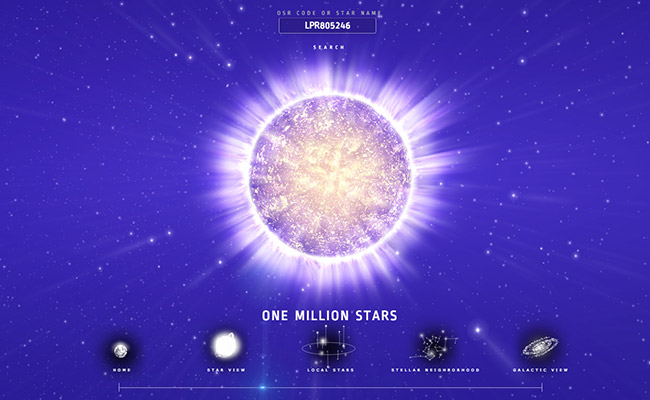One Million Stars: Explore Our Galactic Neighborhood
Discover the universe from the comfort of your own home with the One Million Stars App. It’s a revolutionary way to travel the stars from your web browser. The One Million Stars App allows you to view one million stars, including stars named by astronomers, as well as personalized stars named in the Online Star Register (OSR). Fly through the universe and experience the stars and the galaxy in 3D!

One Million Stars uses real data derived from multiple star catalogs, in addition to stars that have been named in the Online Star Register. When you name a star in the Online Star Register, you can find it in One Million Stars instantly.
What can you do with the One Million Stars App?
Comprehending the immensity of the universe is mind boggling, but with the One Million Stars App, you can become familiar with our galactic neighborhood! With this app from OSR, you can visualize space by taking a tour through our galaxy. You can view 87 popular stars that have been named by astronomers, such as Alpha Centauri, Sirius, and Polaris, but you can also look up and view named stars in the Online Star Register.
When you name a star in the Online Star Register, you can find it in One Million Stars instantly. With the OSR Code you can fly to your star and experience it fully in 3D. Want to see how that works? Check out one of the stars.
Check out our video
The beauty and interactive nature of the One Million Stars Project has to be seen to be believed. Check out our video below that gives you a tour through the application. Then, visit One Million Stars and become a traveler of the Universe!
Name one of the One Million Stars stars now!
About One Million Stars
One Million Stars visualizes roughly one million stars known to astronomers near our Solar System. Of the stars within this data-base 490,932 are displayed as individual particles, each of which contain real spatial coordinates as well as the star’s spectral index which can be resolved to a star color. The data is a collection of HYG, HIPPARCOS, and the RAVE star catalogues, in addition to data from stars that have been named in the Online Star Register.
The site uses a variety of HTML5 features that allow the web-page to be completely interactive. Features include the WebGL library THREE.js and numerous other open source libraries, such as Chance, Howler, Wagner, Ramda and Oboe. Because scientists and astronomers are always learning, and their theories and discoveries are always evolving, complete accuracy cannot be guaranteed. So please do not use this visualization for interstellar navigation. You may get lost :)
Credits
Credits for creating One Million Stars go out to:
- MinMax for the development
- Oleg Galkin (Neoclassic) for composing and producing the sounds
Because One Million Stars was created to evolve, new elements like planets, constellations, and celestial phenomena will be added along the way. Please sign-up for our newsletter to receive the latest updates first!
